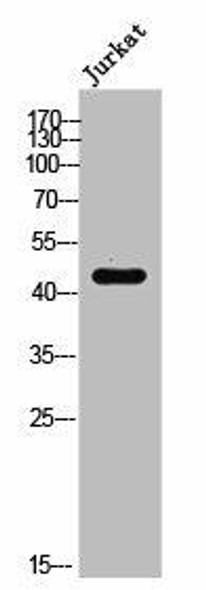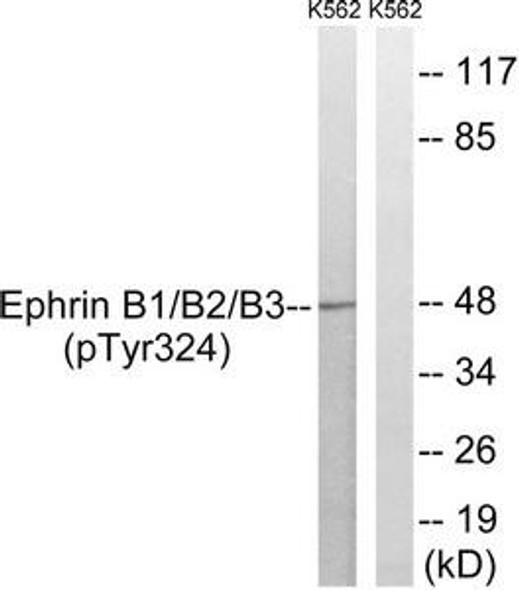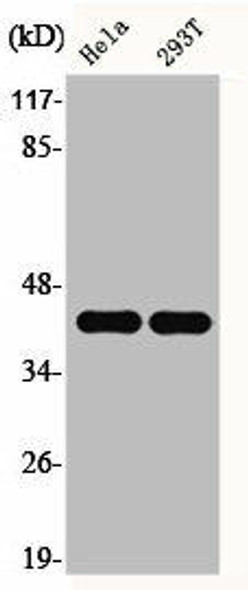Description
| Antibody Name: | Phospho-EFNB1/EFNB2 (Y329) Antibody |
| Antibody SKU: | PACO03584 |
| Size: | 50ug |
| Host Species: | Rabbit |
| Tested Applications: | ELISA, IHC |
| Recommended Dilutions: | IHC:1:100-1:300 |
| Species Reactivity: | Human, Mouse, Rat |
| Immunogen: | synthesized peptide derived from human Ephrin-B1/2 around the phosphorylation site of Y329. |
| Form: | Liquid |
| Storage Buffer: | Liquid in PBS containing 50% glycerol, 0.5% BSA and 0.02% sodium azide. |
| Purification Method: | The antibody was affinity-purified from rabbit antiserum by affinity-chromatography using epitope-specific immunogen. |
| Clonality: | Polyclonal |
| Isotype: | IgG |
| Conjugate: | Non-conjugated |
| Synonyms: | EFNB1; EFL3; EPLG2; LERK2; Ephrin-B1; EFL-3; ELK ligand; ELK-L; EPH-related receptor tyrosine kinase ligand 2; LERK-2; EFNB2; EPLG5; HTKL; LERK5; Ephrin-B2; EPH-related receptor tyrosine kinase ligand 5; LERK-5; HTK ligand; HTK-L |
| UniProt Protein Function: | EFNB1: a type I membrane protein of the ephrin family. A ligand of Eph-related receptor tyrosine kinases EphB1 and EphA1. Ephrins and ephrin receptors mediate numerous developmental processes, particularly in the nervous system. Ephrin-B1 may play a role in cell adhesion and functions in the development or maintenance of the nervous system. Binding to its receptor induces the collapse of commissural axons/growth cones in vitro. Induced by TNF-alpha. Expressed in brain, heart, placenta, lung, liver, skeletal muscle, kidney, and pancreas. |
| UniProt Protein Details: | Protein type:Membrane protein, integral; Ligand, receptor tyrosine kinase Chromosomal Location of Human Ortholog: Xq12 Cellular Component: integral to plasma membrane; cytoplasm; plasma membrane; synapse; nucleus; lipid raft Molecular Function:protein binding; ephrin receptor binding Biological Process: axon guidance; cell-cell signaling; ephrin receptor signaling pathway; positive regulation of T cell proliferation; cell adhesion; embryonic pattern specification; neural crest cell migration Disease: Craniofrontonasal Syndrome |
| NCBI Summary: | The protein encoded by this gene is a type I membrane protein and a ligand of Eph-related receptor tyrosine kinases. It may play a role in cell adhesion and function in the development or maintenance of the nervous system. [provided by RefSeq, Jul 2008] |
| UniProt Code: | P98172 |
| NCBI GenInfo Identifier: | 1706668 |
| NCBI Gene ID: | 1947 |
| NCBI Accession: | P98172.1 |
| UniProt Secondary Accession: | P98172,D3DVU0, |
| UniProt Related Accession: | P98172 |
| Molecular Weight: | 346 |
| NCBI Full Name: | Ephrin-B1 |
| NCBI Synonym Full Names: | ephrin-B1 |
| NCBI Official Symbol: | EFNB1 |
| NCBI Official Synonym Symbols: | CFND; CFNS; EFB1; EFL3; EPLG2; Elk-L; LERK2 |
| NCBI Protein Information: | ephrin-B1; EFL-3; LERK-2; ELK ligand; ligand of eph-related kinase 2; eph-related receptor tyrosine kinase ligand 2 |
| UniProt Protein Name: | Ephrin-B1 |
| UniProt Synonym Protein Names: | EFL-3; ELK ligand; ELK-L; EPH-related receptor tyrosine kinase ligand 2; LERK-2 |
| Protein Family: | Ephrin |
| UniProt Gene Name: | EFNB1 |
| UniProt Entry Name: | EFNB1_HUMAN |






